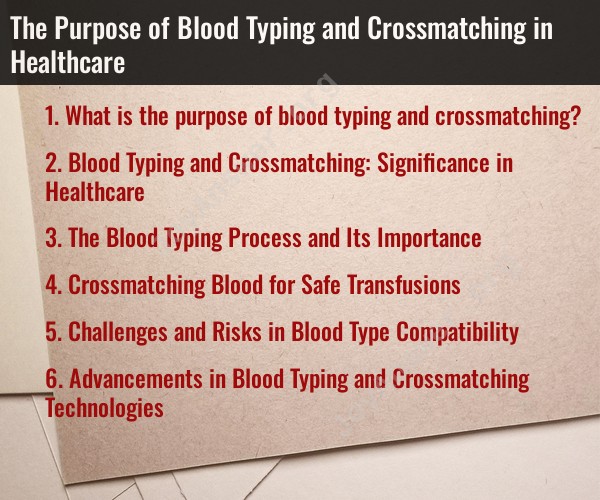What is the purpose of blood typing and crossmatching?
Blood typing and crossmatching are essential processes in healthcare, particularly in the context of blood transfusions. These procedures are performed to ensure patient safety and compatibility when receiving blood or blood products. Here's an explanation of their purposes:
Blood Typing (Blood Grouping):
- Purpose: Blood typing, also known as blood grouping, determines a person's blood group or blood type. There are four main blood groups based on the presence or absence of specific antigens on the surface of red blood cells: A, B, AB, and O. The Rh factor, denoted as positive (+) or negative (-), is another important factor.
- Importance: Knowing a patient's blood type is crucial to prevent adverse reactions during blood transfusions. If incompatible blood is transfused, it can lead to a life-threatening immune response. For example, a person with blood type A should receive type A or type O blood, but not type B or AB blood.
Crossmatching (Compatibility Testing):
- Purpose: Crossmatching is a more specific test that confirms the compatibility of the donor's blood with the recipient's blood. It ensures that the recipient's immune system will not react negatively to the transfused blood.
- Importance: Crossmatching is the final check before a blood transfusion. It is particularly vital when dealing with patients who have a history of transfusion reactions, pregnant individuals, or those in critical conditions. There are two types of crossmatching:a. Major Crossmatch: This involves mixing the recipient's serum with the donor's red blood cells to check for compatibility.b. Minor Crossmatch: This test confirms compatibility by mixing the recipient's red blood cells with the donor's serum.
Blood typing and crossmatching are also crucial in other medical situations, such as organ transplantation, where the donor's blood type must match the recipient's to minimize the risk of organ rejection. These procedures help healthcare professionals ensure that patients receive safe and compatible blood and blood products, reducing the risk of adverse reactions and complications during medical treatments and interventions.
Sure, here is a detailed explanation of the five topics you mentioned:
Blood Typing and Crossmatching: Significance in Healthcare
Blood typing and crossmatching are crucial procedures in healthcare, ensuring the safe and compatible administration of blood transfusions. These processes determine an individual's blood type and test for potential reactions between the donor's blood and the recipient's blood.
The Blood Typing Process and Its Importance
Blood typing identifies an individual's blood group based on the presence or absence of specific antigens on the surface of red blood cells (RBCs). The ABO blood group system is the most widely used, classifying blood into four main types: A, B, AB, and O. Additionally, the Rh factor (positive or negative) is another important determinant of blood compatibility.
Crossmatching Blood for Safe Transfusions
Crossmatching involves mixing a sample of the recipient's blood with a sample of the donor's blood to check for any adverse reactions. This process helps prevent hemolytic reactions, where the recipient's immune system attacks the donor's RBCs, leading to serious complications.
Challenges and Risks in Blood Type Compatibility
While blood typing and crossmatching are highly accurate, there are certain challenges and risks to consider:
Transfusion reactions: Despite careful matching, rare reactions may occur due to unexpected antibodies or other factors.
ABO incompatibility: Transfusing incompatible blood can lead to severe hemolytic reactions, even if crossmatching is performed.
Rh incompatibility: Rh-positive blood transfused into an Rh-negative recipient can cause sensitization, leading to complications in subsequent pregnancies.
Advancements in Blood Typing and Crossmatching Technologies
Advances in technology are improving blood typing and crossmatching processes:
Automated systems: Automated systems are increasingly used for blood typing and crossmatching, reducing human error and improving efficiency.
Molecular techniques: Molecular techniques are being developed to identify rare blood types and potential transfusion reactions more accurately.
Universal blood: Research is ongoing to develop universal blood types that can be transfused safely into individuals of any blood group.
These advancements aim to enhance the safety and effectiveness of blood transfusions, saving lives and improving patient outcomes.













